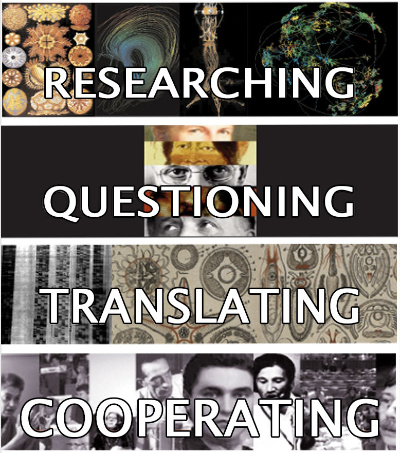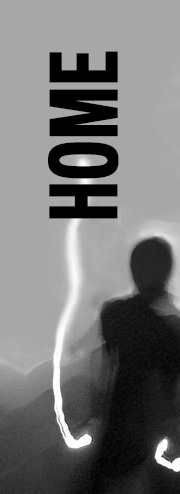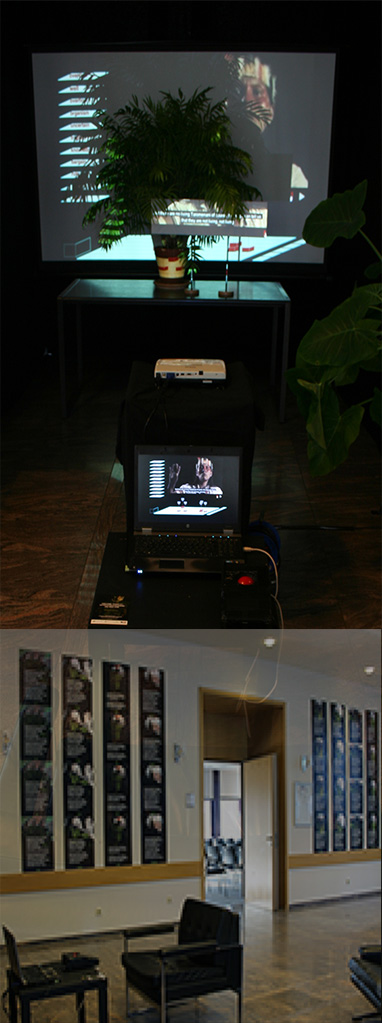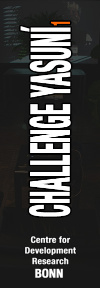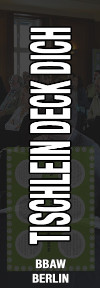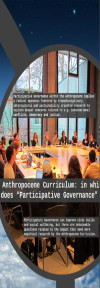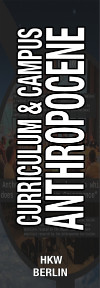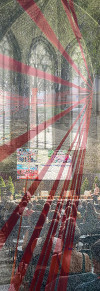RESEARCHING: into how we live and how we want to live together. One of the social functions of RESEARCH ARTS involves developing socially relevant heuristics and innovation. This is the knowledge generated by inter- and trans-disciplinary cooperative processes. This kind of research project requires the translation or transfer of knowledge, the exchange between research practices in all fields of knowledge, and, above all, an openness for non-disciplinary knowledge and unpredictable influences. Other relevant artistic and scientific cooperation processes can be observed in the development of the "third scientific method", for instance in research with simulation models. The term heuristic in relation to the field of Research Arts is based on Larry Laudans’ definition of it being seen “as a problem and its corresponding problem-solving”. Furthermore, the term includes here the proposed definition by Hans Vaihinger of the "heuristic fiction". The focus of the "heuristic fiction" is the boundary of a scientifically defined nature inherent in some research practices, for example, in relation to the verification by artists of research results. "Heuristic fiction" refers to the social benefits and advantages of such research: even when assuming false, fictitious or unprovable parameters, they can identify important new areas of research. RESEARCH ARTS aims to contribute to the diversity of methods by formulating hypotheses, examining technologies for their level of sustainability or developing new methods of activity or company practices.
TRANSLATING: between manifold languages of science, multiple perceptions of reality, the diverse concepts of value and worth, and different forms of memory. The social function of translation and memory, within the artistic and scientific system, is based on the coexistence of different forms of memory. The parallel development of different perceptions of reality - such as non-overlapping analysis of reality - creates the need for translation models and comparison methods. Furthermore, it involves the circulation of knowledge through new forms of communication and archive models, which need to be continually updated and expanded. In this context, RESEARCH ARTS studies, for example, the structural transformation of collective social memory, like a cabinet of curiosities accumulating a "collection" of research objects…. taking stock of the systematized archives of knowledge such as libraries as well as the many new possibilities provided by the dynamic memory of networked databases. The comparison methods of the RESEARCH ARTS field of study allows one to clarify and resolve problems relating to the communication of knowledge by making use of metaphoric principles such as resemblance or analogy. Comparison fields are generated, which precede the research and are necessary to identify the conditions and possible difficulties associated with the new or unfamiliar. Skills in such a translation practice are acquired by attempting to approach uncertainties, paradoxes, blind spots, ignorance, strangeness, etc. through the generation of hypothetical models. These models again and again refresh what the memory of a system includes and excludes. Making use of these hypothetical models, for instance with the help of similarity, equivalence and analogy structures, the possibilities of the connectivity of a system can be renewed and tested.
QUESTIONING: the world we live in and the way we want to participate in shaping this world. The social function of the RESEARCH ARTS fields of questioning refers to the observation, self-observation and self-criticism of different social systems (Niklas Luhmann). The capability of this function relies on being able to distinguish between different forms of observation and setting them in relation to each other: 1. observations that establishes a direct relationship with the world without distinguishing between object and subject (first-order observation), 2. observations based on the observation of the observer - for example, public opinion regarding science or scientific reviews (second-order observation), and 3. the observation of the self-observing researcher (third-order observation). Self-observation in science takes place, for example, in dealing with publications. These publications may have different goals, such as obtaining support for an idea or the attempt to deflect criticism, as heuristics (in order to create new methods or knowledge) or as criticism (to contextualize the conditions of production). Another example of self-observation is the artist seen as a "uninvolved and critical commentator". The criticism then develops from the "hetero-observation" of another system: the artist can for example question the conditions or the socio-political contexts in which science is produced. In this way, the social impact, user behavior or the social uses or misuses of scientific results are questioned.
COOPERATING: to encourage creative participatory processes between "experts from different disciplines" and the “experts of everyday knowledge". The social function of the RESEARCH ARTS field of “cooperating”, deals with the theory of action, with socially involved artistic & scientific practices and science communication. The theory of action is appropriate in the way it deals with the result of certain actions: the effect of symbolic acts, such as a staged rescue attempt, which may have a limited social impact, or such as the real act of direct action, which may lead to irreversible social consequences. The aim of RESEARCH ARTS in this area is to grasp the potential or demonstrable effects that artistic-scientific cooperation projects have on society. The RESEARCH ARTS field of “cooperating” also searches for sensible methods of participatory engagement and communication. This approach also tries to develop these exemplary academic & artistic practices further by transferring them to other contexts, such as into a political context. In a political context, it is committed to rethink normative formats of democratic participation and to increase involvement in issues of social responsibility. Another facet of this form of action is the development and testing of new formats of participation within the “shared space” of the city or in scientific contexts such as in science museums.
INVESTIGAR: sobre com vivim i com volem viure junts. Una de les funcions socials del RESEARCH ARTS consisteix en desenvolupar heurístiques i innovacions socialment rellevants. Aquesta forma de coneixement és generat en processos cooperatius inter- i transdisciplinaris, en projectes de recerca que requereixen la traducció o transferència de coneixement, l'intercanvi entre pràctiques de recerca en tots els àmbits del coneixement i, sobretot, una obertura al coneixement no disciplinari i a les influències imprevisibles. Altres processos de cooperació artística i científica rellevants es poden observar en el desenvolupament del "tercer mètode científic", per exemple en la recerca amb models de simulació. El terme heurístic en relació amb l'àmbit del research arts es basa en la definició de Larry Laudans que ell definieix "com un problema i la seva corresponent resolució del problema". A més, el terme inclou la definició proposada per Hans Vaihinger de la "ficció heurística". El focus de la "ficció heurística" és el límit d'una naturalesa que s’estudia i defineix científicament definida, per exemple, en relació a la verificació per part dels artistes dels resultats de la recerca. La "ficció heurística" fa referència als beneficis i avantatges socials d'aquesta investigació: fins i tot en assumir paràmetres falsos, ficticis o no demostrables, poden identificar noves àrees de recerca importants. RESEARCH ARTS pretén contribuir a la diversitat de mètodes formulant hipòtesis, examinant les tecnologies pel seu nivell de sostenibilitat o desenvolupant nous mètodes d'activitat o pràctiques de transformació social.
TRADUIR: entre múltiples llenguatges de la ciència, distintes percepcions de la realitat, diversos conceptes de valor i diferents formes de memòria. La funció social de la traducció i la memòria, dins del sistema de l’art i de la ciència, es basa en la coexistència de diferents formes de memòria. El desenvolupament paral·lel de diferents percepcions de la realitat -com ara anàlisis de la realitat que no es solapen- crea la necessitat de models de traducció i mètodes de comparació. A més, implica la circulació del coneixement a través de noves formes de comunicació i models d'arxiu, que cal actualitzar i ampliar contínuament. En aquest context, research arts estudia, per exemple, la transformació estructural de la memòria social col·lectiva, com un gabinet de curiositats que acumula una "col·lecció" d'objectes de recerca... fer balanç dels arxius sistematitzats de coneixement com les biblioteques, així com de les moltes noves possibilitats que ofereix la memòria dinàmica de les bases de dades en la xarxa d’internet. Els mètodes de comparació de l'àmbit d'estudi research arts permeten aclarir i resoldre problemes relacionats amb la comunicació del coneixement fent ús de principis metafòrics com la semblança o l'analogia. Es generen camps de comparació, que precedeixen la recerca i són necessaris per identificar les condicions i les possibles dificultats associades al que ens es nou o desconegut. Les habilitats en aquesta pràctica de traducció s'adquireixen intentant aproximar-se a incerteses, paradoxes, punts cecs, ignorància, estranyesa, etc. mitjançant la generació de models hipotètics. Aquests models refresquen una i altra vegada allò que la memòria d'un sistema inclou i exclou. Fent ús d'aquests models hipotètics, per exemple amb l'ajuda d'estructures de semblança, equivalència i analogia, es poden renovar i provar les possibilitats de connectivitat d'un sistema.
QUESTIONAR: el món en què vivim i la manera com volem participar en la configuració d'aquest món. La funció social d’aquest camp d’estudi del research artsfa referència a l'observació, l'autoobservació i l'autocrítica de diferents sistemes socials (Niklas Luhmann). La capacitat d'aquesta funció es basa en ser capaç de distingir entre diferents formes d'observació i posar-les en relació entre si: 1. observacions que estableixen una relació directa amb el món sense distingir entre objecte i subjecte (observació de primer ordre), 2. . les observacions basades en l'observació de l'observador -per exemple, l'opinió pública sobre la ciència o les revisions científiques (observació de segon ordre), i 3. l'observació de l'investigador autoobservador (observació de tercer ordre). L'autoobservació en la ciència es practica, per exemple, en diferents formes de fer servir publicacions científiques. Aquestes publicacions poden tenir diferents objectius, com l'obtenció de suport a una idea (o l'intent de desviar la crítica), com a heurístiques (per tal de crear nous mètodes o coneixements) o com a crítica (per contextualitzar les condicions de producció). Un altre exemple d'autoobservació és l'artista vist com un "comentador no implicat i/o crític". La crítica es desenvolupa llavors a partir de l'"heteroobservació" d'un altre sistema: l'artista pot, per exemple, qüestionar les condicions o els contextos sociopolítics en què es produeix la ciència. D'aquesta manera, es qüestiona l'impacte social, el comportament dels usuaris o els usos o mals usos socials dels resultats científics.
COOPERAR: per fomentar processos creatius de participació entre "experts de diferents disciplines" i els "experts del coneixement quotidià". La funció social de l'àmbit del research arts de enfocat a "cooperar", enclou “la teoria de l'acció”, pràctiques artístiques i científiques implicades socialment, i la comunicació científica. En aquest context, la teoria de l'acció és adequada en la manera en què tracta el resultat de determinades accions: per exemple l'efecte d'actes simbòlics, com un intent de rescat escenificat, que pot tenir una impacte social limitat, o com l'acte real de l'acció directa, que pot comportar conseqüències socials irreversibles. L'objectiu del research arts en aquest àmbit és copsar els efectes potencials o demostrables que els projectes de cooperació artístico-científica tenen en la societat. L'àmbit del research arts "cooperant" també cerca mètodes assenyats de participació i comunicació. Aquest enfocament intenta desenvolupar pràctiques acadèmiques i artístiques exemplars, transferint-les a altres contextos, com ara un context polític. En un context polític, aposta per repensar els formats normatius de participació democràtica i per augmentar la implicació en temes de responsabilitat social. Una altra faceta d'aquesta forma d'acció és el desenvolupament i prova de nous formats de participació dins de l'"espai compartit" de la ciutat o l’àmbit rural així com en contextos científics com ara els museus científics.
